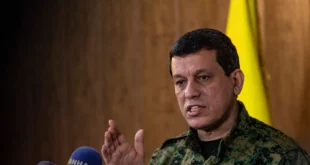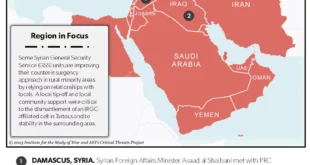US, Ukrainian, and Russian officials reached some agreements for temporary ceasefires on strikes against energy infrastructure and in the Black Sea. The details of these ceasefires remain unclear and evaluating the ceasefires’ specifics in the absence of officially published joint texts of the agreements signed by Russia and Ukraine remains difficult. The White House issued one readout about the outcomes of the US-Russian talks in Saudi Arabia from March 24 and another about the US-Ukrainian talks from March 25.[1] The Kremlin and Ukrainian Defense Minister Rustem Umerov each issued separate statements for Russia and Ukraine.[2] The American, Russian, and Ukrainian statements share some commonalities but differ from each other significantly in other regards. The US readouts, the Kremlin readout, and Umerov commonly stated that the United States, Ukraine, and Russia “agreed to develop measures for implementing” US President Donald Trump’s, Ukrainian President Volodymyr Zelensky’s, and Russian President Vladimir Putin’s “agreement to ban strikes against energy facilities of Russia and Ukraine.”[3] Zelensky stated that Ukraine also gave the United States a list of “strategic infrastructure objects” that Ukraine would like protected under a strikes ceasefire.[4] This list is not explicitly mentioned in the US or Russian readouts. The Kremlin later issued a list of Russian and Ukrainian facilities that Russian and American delegations agreed fall under the temporary ceasefire on strikes on the energy system.[5] The Kremlin stated that the list includes oil refineries; oil and gas pipelines and storage facilities, including pumping stations; electricity generation and transmission infrastructure, including power plants, substations, transformers, and distributors; nuclear power plants; and hydroelectric dams. It is unclear if the Russian list of objects is the same list of “strategic infrastructure objects” that Zelensky mentioned. The Kremlin stated that the temporary ceasefire is valid for 30 days starting from March 18, 2025, meaning that the ceasefire will by default expire on April 17, 2025, unless Russia and Ukraine mutually agree to renew it. The Kremlin stated that Russia and Ukraine have the right to consider themselves free from the obligations of the agreement if one of the parties violates the agreement. The mechanisms to monitor and address allegations of violations remain unclear. The Kremlin’s list notably only includes energy infrastructure facilities, and it remains unclear whether discussions regarding Zelensky’s list of other non-energy facilities that he wants protected under the ceasefire are still ongoing or whether the Kremlin has rejected Zelensky’s proposal. Umerov also stated that Ukraine is ready to “ready to organize a separate meeting at the technical level to begin work on implementation mechanisms” for the strikes and Black Sea ceasefires and that “at this point, all parties are going to brief the relevant leadership, and we will announce the dates and times soon.”[6] The Kremlin’s and Umerov’s statements suggest that Russia and Ukraine may not yet be in agreement about whether the ceasefire has gone into effect or not as of March 25.
The US readouts of its bilateral meetings in Saudi Arabia and Umerov noted that the United States, Ukraine, and Russia “agreed to ensure safe navigation, eliminate the use of force, and prevent the use of commercial vessels for military purposes in the Black Sea.”[7] The Kremlin readout of the US-Russian talks similarly stated that the United States and Russia agreed to such measures as part of a “Black Sea Initiative,” but added that there need to be “appropriate control measures through inspection of such vessels.”[8] Umerov uniquely added that all Russian military vessels movement “outside of [the] eastern part of the Black Sea” will constitute a violation of the spirit of this agreement and that Ukraine will regard such movement as a violation of the commitment to ensure the safe navigation of the Black Sea and a threat Ukraine’s national security.[9] Umerov stated that Ukraine will be able to exercise its right to self-defense in the event of such violations.
All readouts of the March 23 to 25 bilateral meetings noted that the parties “welcome the good offices of third countries with a view toward supporting the implementation of the energy and maritime agreements” and that all parties “will continue working toward achieving a durable and lasting peace.”[10] (Turkey notably helped facilitate the July 2022 grain deal by inspecting commercial vessels transporting foodstuffs in the Black Sea.)[11] The White House and Umerov stated that the United States and Ukraine “agreed that the United States remains committed to helping achieve prisoners of war (POWs) exchanges, the release of civilian detainees, and the return of forcibly transferred Ukrainian children.”[12]
Putin continues to reject Trump’s and Zelensky’s proposed temporary frontline ceasefire, despite agreeing to some form of ceasefire for strikes on energy infrastructure and in the Black Sea. Putin’s persistent stalling and intransigence are inhibiting Trump’s efforts to secure a lasting and stable peace settlement. The US readouts for both its meetings with Russian and Ukrainian delegations noted that Trump’s “imperative that the killing on both sides” of the war must stop, “as the necessary step toward achieving an enduring peace settlement” — likely in reference to the unconditional 30-day general ceasefire on the frontline that Trump and Zelensky have already agreed upon, but that Putin rejected on March 18.[13]
The Kremlin stated that it will not implement the agreed ceasefire in the Black Sea until the United States lifts sanctions on Russian state-owned agricultural bank Rosselkhozbank and other unspecified financial organizations involved in international food and fertilizer trade.[14] The Kremlin stated that unspecified actors — presumably the United States — must also reconnect Rosselkhozbank and other unspecified financial organizations to SWIFT and lift restrictions on trade finance transactions. Additionally, they must lift sanctions restricting companies producing and exporting food and fertilizers and their insurance companies, lift restrictions on servicing ships in ports and sanctions against ships operating under the Russian flag involved in trading food and fertilizer products, and lift restrictions on supplying agricultural machinery and other tools used in food and fertilizer production to Russia. The United States did not provide Russia such demanded sanctions relief when Ukraine and Russia agreed to the grain deal in July 2022.[15] The White House and Kremlin readouts of the US-Russian meetings noted that the “United States will help restore Russia’s access to the world market for agricultural and fertilizer exports, lower maritime insurance costs, and enhance access to ports and payment systems for such transactions,” but the US readout notably did not include explicit language suggesting that Russia‘s acceptance and adherence to the Black Sea ceasefire would be conditional on preliminary US sanctions relief.[16] The United States will likely require European Union (EU) cooperation in order to lift some sanctions and restrictions on Russian agricultural, financial, and trade entities to reconnect Russia to international agricultural and fertilizer markets.[17] US President Donald Trump responded to a question about the United States lifting some sanctions on Russia before Russia implements measures in the Black Sea and stated that the US is considering lifting some sanctions against Russia.[18] Establishing the initial grain deal in July 2022 did not require any sanctions relief, and reinstating the grain deal likely similarly does not require preliminary sanctions relief.[19] Establishing a temporary ceasefire in the Black Sea does not require preliminary sanctions relief.
The Kremlin’s official statements are vague, stipulate requirements for the ceasefire that neither the United States nor Ukrainian official statements mention, and leave room for disagreement among the parties that would be involved in interpreting the agreements, lifting sanctions, and monitoring potential violations. The official Kremlin statement is vague on the specific sanctions and restrictions the Kremlin is demanding that the West preliminarily lift and the specific financial organizations and companies involved. The Kremlin statement also does not specify the actors that will interpret the parameters of these restrictions, monitor lifting these restrictions, and verify all parties’ compliance. Ukrainian President Volodymyr Zelensky stated that Ukraine, Russia, and the United States issued separate statements because the US-Ukrainian meetings did not discuss US-Russian efforts to assist restoring Russian access to agricultural and trade markets.[20]
Key Takeaways:
US, Ukrainian, and Russian officials reached some agreements for temporary ceasefires on strikes against energy infrastructure and in the Black Sea. The details of these ceasefires remain unclear and evaluating the ceasefires’ specifics in the absence of officially published joint texts of the agreements signed by Russia and Ukraine remains difficult.
The Kremlin's and Umerov's statements suggest that Russia and Ukraine may not yet be in agreement about whether the ceasefire has gone into effect or not as of March 25.
Putin continues to reject Trump's and Zelensky's proposed temporary frontline ceasefire, despite agreeing to some form of ceasefire for strikes on energy infrastructure and in the Black Sea. Putin’s persistent stalling and intransigence are inhibiting Trump's efforts to secure a lasting and stable peace settlement.
The Kremlin stated that it will not implement the agreed ceasefire in the Black Sea until the United States lifts sanctions on Russian state-owned agricultural bank Rosselkhozbank and other unspecified financial organizations involved in international food and fertilizer trade.
Russian forces recently advanced in the Kursk-Sumy Oblast border area, near Toretsk, and in western Zaporizhia Oblast.
The Russian military continues to deny rotations to soldiers who have been fighting in the war in Ukraine for years.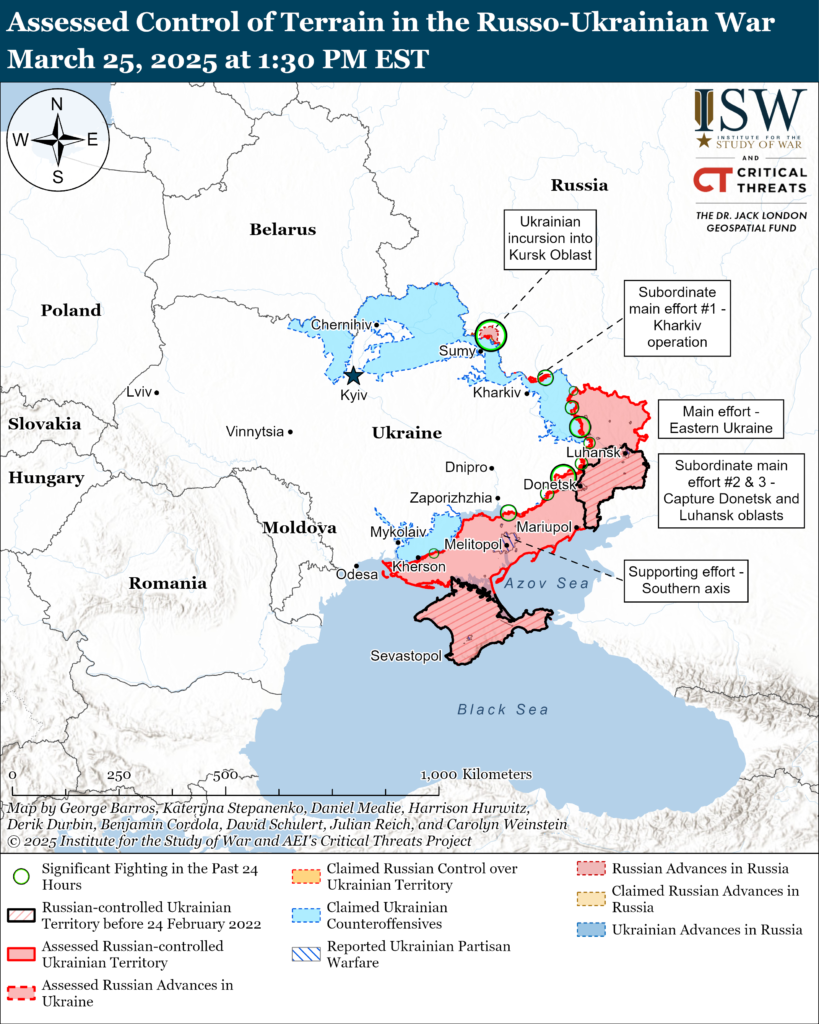
We do not report in detail on Russian war crimes because these activities are well-covered in Western media and do not directly affect the military operations we are assessing and forecasting. We will continue to evaluate and report on the effects of these criminal activities on the Ukrainian military and the Ukrainian population and specifically on combat in Ukrainian urban areas. We utterly condemn Russian violations of the laws of armed conflict and the Geneva Conventions and crimes against humanity even though we do not describe them in these reports.
Ukrainian Operations in the Russian Federation
Russian Main Effort – Eastern Ukraine (comprised of three subordinate main efforts)
Russian Subordinate Main Effort #1 – Push Ukrainian forces back from the international border with Belgorod Oblast and approach to within tube artillery range of Kharkiv City
Russian Subordinate Main Effort #2 – Capture the remainder of Luhansk Oblast and push westward into eastern Kharkiv Oblast and encircle northern Donetsk Oblast
Russian Subordinate Main Effort #3 – Capture the entirety of Donetsk Oblast
Russian Supporting Effort – Southern Axis
Russian Air, Missile, and Drone Campaign
Russian Mobilization and Force Generation Efforts
Russian Technological Adaptations
Activities in Russian-occupied areas
Significant Activity in BelarusUkrainian Operations in the Russian Federation
Russian forces recently advanced in the Kursk-Sumy Oblast border area amid continued attacks on limited Ukrainian positions in Kursk Oblast on March 25.
Assessed Russian advances: Geolocated footage published on March 24 indicates that Russian forces recently advanced within and east of Zhuravka (northeast of Sumy City along the international border).[21]
Unconfirmed claims: A Russian milblogger claimed on March 25 that elements of the Russian 22nd Motorized Rifle Regiment (72nd Motorized Rifle Division, 44th Army Corps [AC], Leningrad Military District [LMD]) advanced near Guyevo (south of Sudzha).[22]
Russian forces attacked near Gogolevka (west of Sudzha); near the Sudzha checkpoint along the international border southwest of Sudzha; and north to northeast of Sumy City along the international border near Volodymyrivka, Veselivka, Zhuravka, and Basivka on March 24 and 25.[23]
Order of Battle: Elements of the Russian 119th Airborne (VDV) Regiment (106th VDV Division) and drone operators of the Rubicon Center for Advanced Unmanned Technologies are reportedly operating in Kursk Oblast.[24]
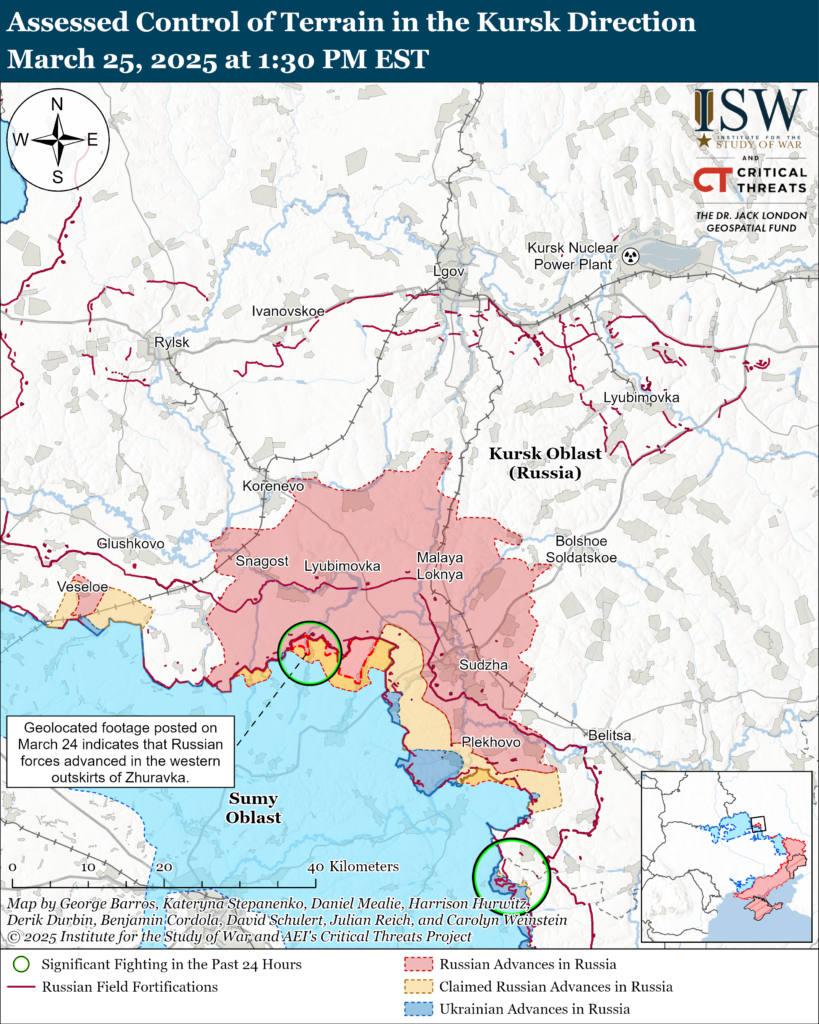
Ukrainian forces recently advanced along the international border in northwestern Belgorod Oblast.
Assessed advances: A Kremlin-affiliated Russian milblogger claimed on March 24 that Ukrainian forces recently advanced west of Demidovka and northwest of Popovka (both northwest of Belgorod City).[25]
Unconfirmed claims: Russian milbloggers claimed that Russian forces seized Demidovka and Popivka and advanced southeast of Demidovka and west of Prilesye (northwest of Belgorod City).[26] Other Russian milbloggers claimed that Ukrainian forces attacked Demidovka and that the southern part of the settlement is a contested “gray zone.”[27]
Several Russian milbloggers claimed that Russian forces, including reserve Russian Federal Security Service (FSB) border guards from Primorsky Krai and elements of the 128th Motorized Rifle Brigade (44th AC, LMD) repelled Ukrainian attacks toward Popovka on the night of March 24 to 25.[28]
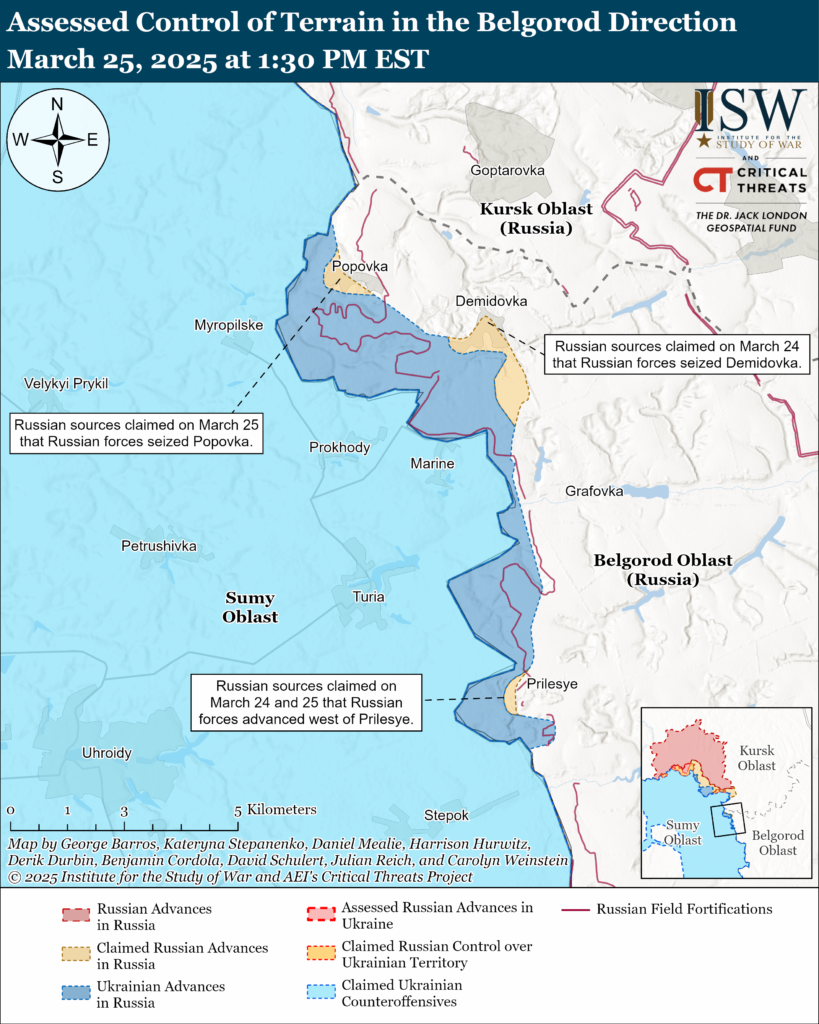
Russian Main Effort – Eastern Ukraine
Russian Subordinate Main Effort #1 – Kharkiv Oblast (Russian objective: Push Ukrainian forces back from the international border with Belgorod Oblast and approach to within tube artillery range of Kharkiv City)
Russian forces continued offensive operations in the Kharkiv direction on March 25 but did not advance.
Russian forces conducted ground attacks northeast of Kharkiv City near Vovchansk on March 24 and 25.[29]
Russian Subordinate Main Effort #2 – Luhansk Oblast (Russian objective: Capture the remainder of Luhansk Oblast and push westward into eastern Kharkiv Oblast and northern Donetsk Oblast)
Russian forces continued offensive operations in the Kupyansk direction on March 25 but did not make confirmed advances.
Unconfirmed claims: Russian sources claimed that Russian forces advanced near Topoli, Kamyanka (both northeast of Kupyansk), Dvorichna (north of Kupyansk), and Stepova Novosilka (southeast of Kupyansk).[30]
Russian forces attacked northeast of Kupyansk near Kamyanka; east of Kupyansk near Petropavlivka; and southeast of Kupyansk near Stepova Novoselivka on March 24 and 25.[31]
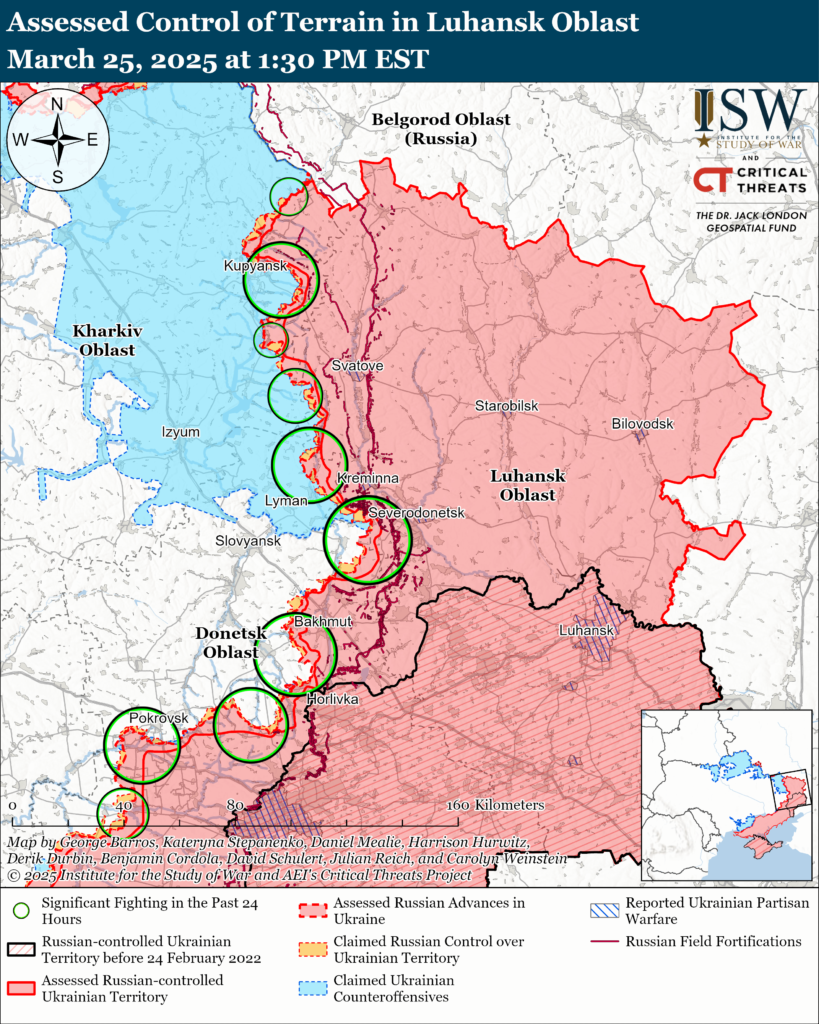
Russian forces continued offensive operations in the Borova direction on March 25 but did not advance.
Russian forces attacked northeast of Borova near Zahryzove; east of Borova near Kopanky; and southeast of Borova toward Novomykhailivka and Katerynivka and near Cherneshchyna on March 24 and 25.[32]
Russian forces continued offensive operations in the Lyman direction on March 25 but did not make confirmed advances.
Unconfirmed claims: The Russian Ministry of Defense (MoD) claimed on March 25 that Russian forces seized Myrne (northeast of Lyman).[33]
Russian forces conducted offensive operations northeast of Lyman near Kolodyzai and Yampolivka and toward Nove and Zarichne; and east of Lyman near Torske on March 24 and 25.[34]
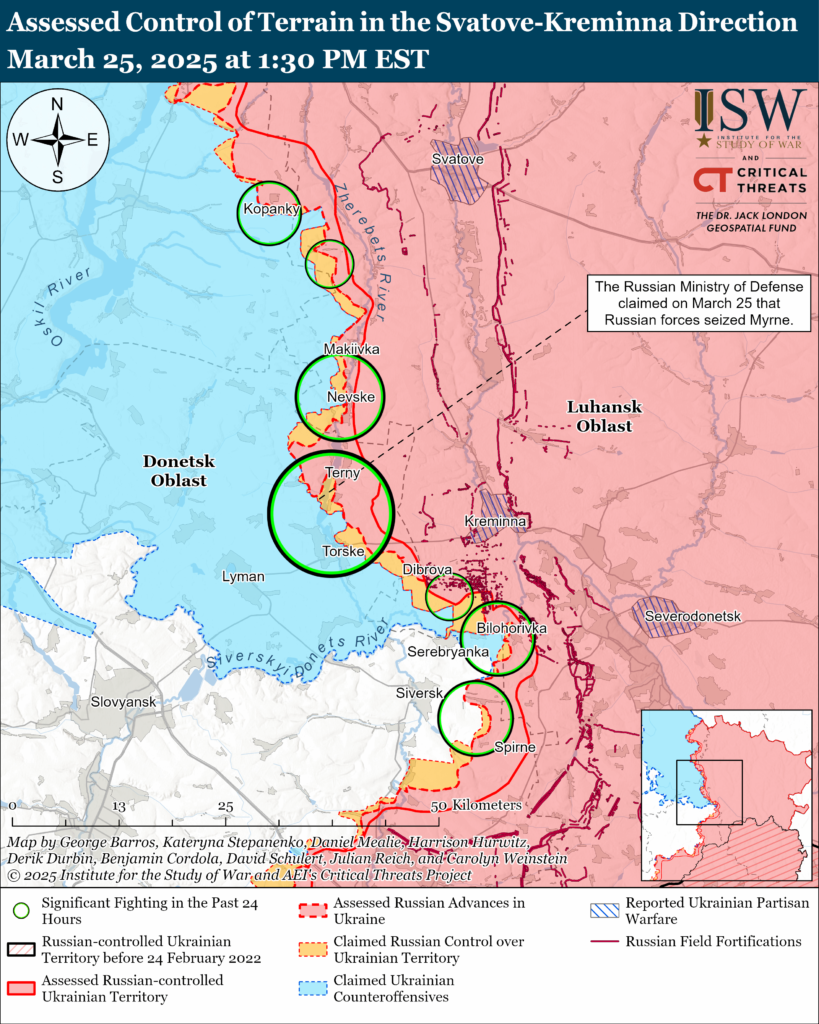
Russian Subordinate Main Effort #3 – Donetsk Oblast (Russian objective: Capture the entirety of Donetsk Oblast, the claimed territory of Russia’s proxies in Donbas)
Russian forces continued offensive operations in the Siversk direction on March 25 but did not advance.
Russian forces conducted offensive operations northeast of Siversk near Hryhorivka and Bilohorivka, east of Siversk near Verkhnokamyanske, and southeast of Siversk near Ivano-Daryivka on March 24 and 25.[35]
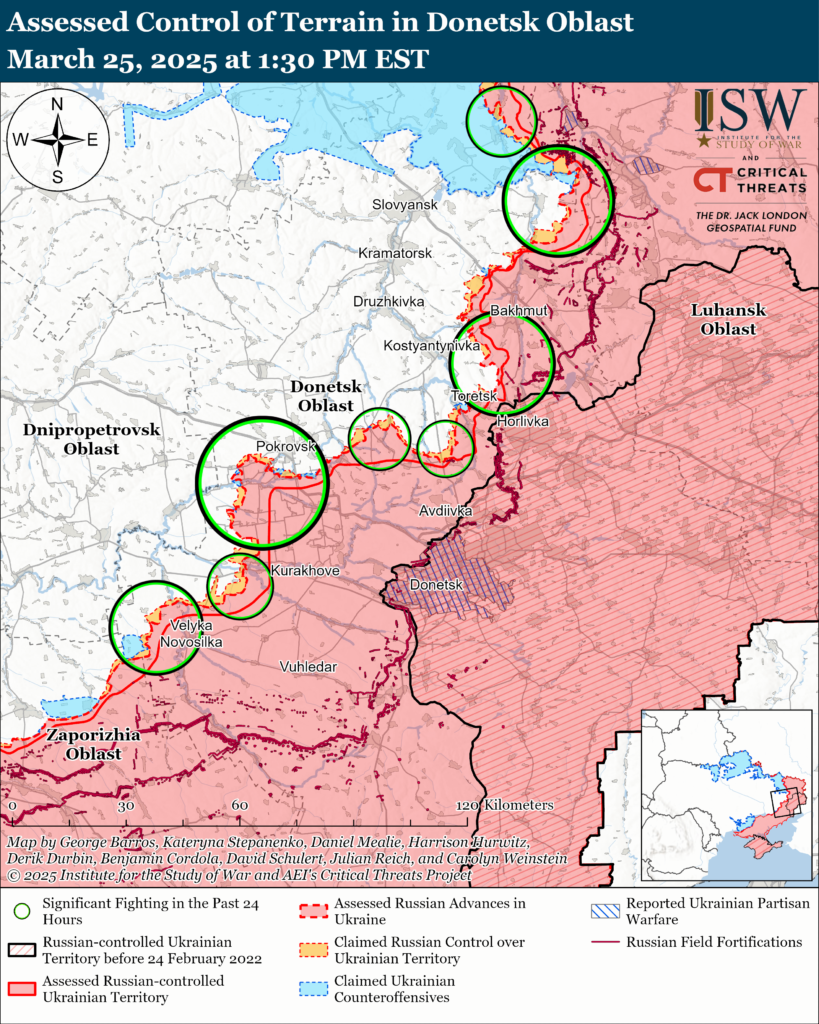
Russian forces continued offensive operations in the Chasiv Yar direction on March 25 but did not advance.
Russian forces conducted offensive operations near Chasiv Yar itself and south of Chasiv Yar toward Predtechyne and Dyliivka on March 24 and 25.[36]
Russian forces recently advanced in the Toretsk direction.
Assessed Russian advances: Geolocated footage published on March 25 indicates that Russian forces recently advanced in northwestern Toretsk and central Oleksandropil (southwest of Toretsk).[37] Additional geolocated footage published on March 21 indicates that Russian forces recently advanced on the southeastern outskirts of Shcherbynivka (west of Toretsk).[38]
Unconfirmed claims: Russian milbloggers claimed that elements of the Russian 150th Motorized Rifle Division (8th Combined Arms Army [CAA], Southern Military District [SMD]), including elements of its 68th Tank Regiment, seized Oleksandropil and Panteleymonivka (north of Oleksandropil).[39] A Russian source claimed that reports that Russian forces seized Oleksandropil and Panteleymonivka are inaccurate.[40] Russian milbloggers claimed that Russian forces advanced in southwestern Toretsk, north and northwest of Toretsk, west of Leonidivika (west of Toretsk), and northwest of Oleksandropil.[41] A Russian milblogger claimed that Ukrainian forces seized Shcherbynivka and Leonidivka.[42]
Russian forces conducted offensive operations near Toretsk itself; north of Toretsk near Dyliivka and Dachne; and east of Toretsk near Krymske on March 24 and 25.[43]
Order of Battle: Elements of the Russian 68th Tank Regiment and 103rd Motorized Rifle Regiment (both of the 150th Motorized Rifle Division) are reportedly operating near Shcherbynivka and Leonidivka.[44]Elements of the Russian 102nd Motorized Rifle Regiment (150th Motorized Rifle Division) are reportedly operating near Toretsk.[45]
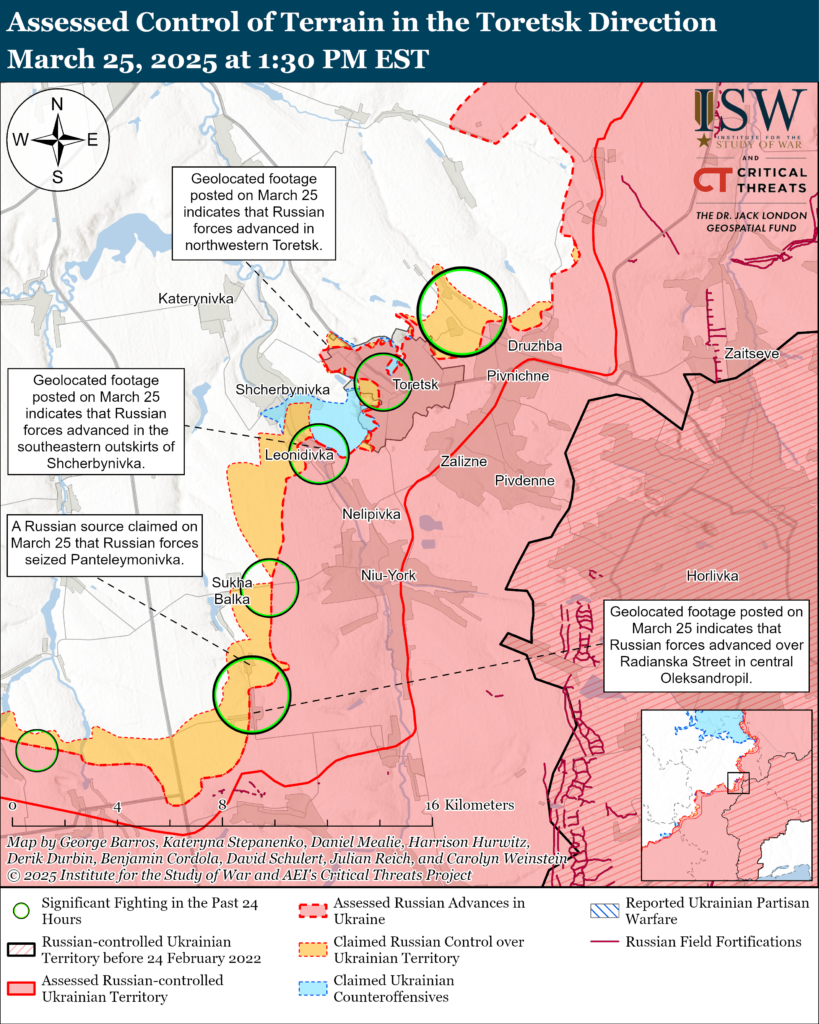
Russian forces continued offensive operations in the Pokrovsk direction on March 25 but did not make confirmed advances.
Unconfirmed claims: Russian milbloggers claimed that Russian forces advanced northwest of Shevchenko, northeast of Pishchane, west of Uspenivka, west of Nadiivka, and within Solone (all southwest of Pokrovsk).[46] A Russian source claimed that Russian forces pushed Ukrainian forces out of Uspenivka.[47] Russian milbloggers claimed that Ukrainian forces occupied half of Solone, roughly half of Tarasivka, and residential areas near Kotlyne.[48]
Russian forces attacked near Pokrovsk itself; east of Pokrovsk near Zelene Pole and Yelyzavetivka; southeast of Pokrovsk near Lysivka and Sukhyi Yar; south of Pokrovsk near Shevchenko and Vidrodzhennya (formerly Novyi Trud); southwest of Pokrovsk near Kotlyne, Udachne, Preobrazhenka, Bohdanivka, Uspenivka, and Solone and toward Novoserhiivka and Kotlyarivka on March 24 and 25.[49] Ukrainian forces counterattacked northeast of Pokrovsk near Tarasivka, south of Pokrovsk near Shevchenko, and southwest of Pokrovsk near Udachne and Kotlyne.[50]
Ukraine’s Khortytsia Group of Forces Spokesperson Major Viktor Trehubov stated on March 24 that Russian attacks in the Pokrovsk direction recently intensified after a recent brief pause but that the intensity of Russian attacks is not as high as in February 2025, likely due to large Russian personnel and equipment losses.[51] The head of the electronic and cyber warfare service of a Ukrainian brigade operating in the Pokrovsk direction stated that Russian forces are using an average of 100 to 150 first-person view (FPV) drones per day in the Pokrovsk direction but that Russian drone usage depends on weather conditions.[52]
Order of Battle: Elements of the Russian 90th Tank Division (41st CAA, Central Military District [CMD]) are reportedly operating near Sribne (southwest of Pokrovsk).[53] Elements of the 506th and 589th motorized rifle regiments (both of the 27th Motorized Rifle Division, 2nd CAA, CMD) are reportedly operating near Uspenivka.[54] Elements of the 433rd Motorized Rifle Regiment (27th Motorized Rifle Division), 30th Motorized Rifle Brigade (2nd CAA, CMD), and 1453rd Regiment (1st Slavic Motorized Rifle Brigade, 51st CAA, SMD) are reportedly operating near Solone.[55] Elements of the 33rd Motorized Rifle Regiment (20th Motorized Rifle Division) are reportedly operating near Tarasivka.[56] Drone operators of the “Vizantiya” detachment and Vanya Ivanov group are reportedly operating in the Pokrovsk direction.[57]
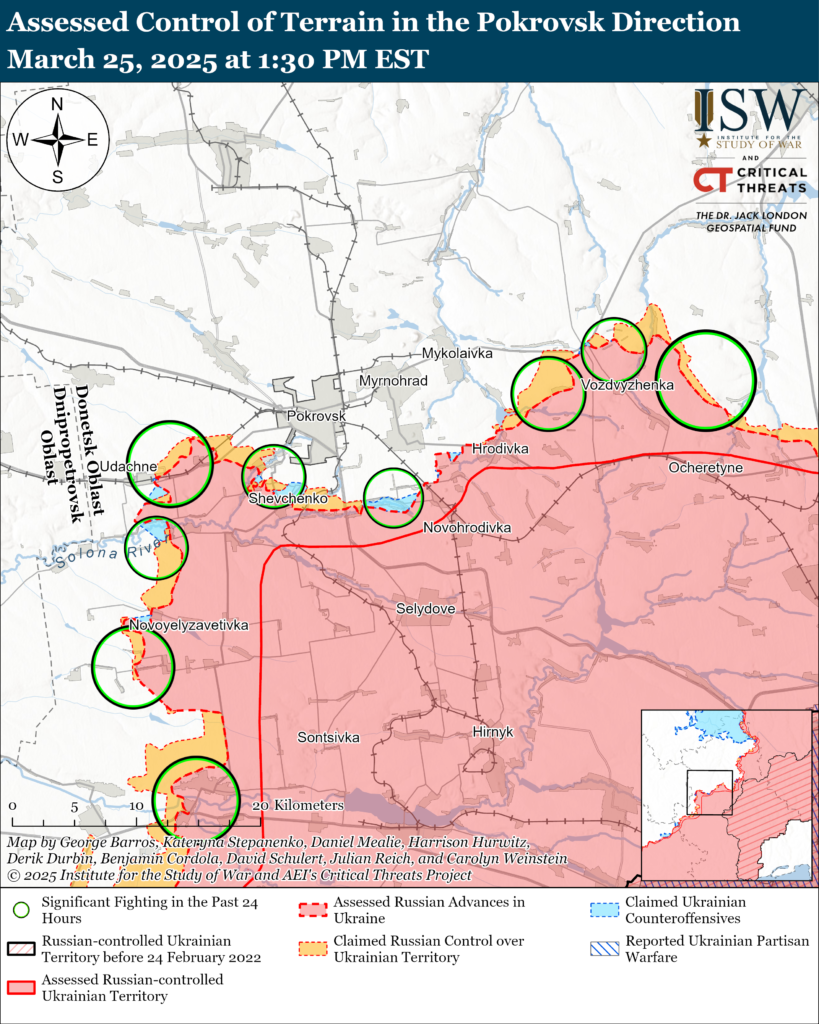
Russian forces continued offensive operations in the Kurakhove direction on March 25 but did not make confirmed advances.
Unconfirmed claims: Russian milbloggers claimed that Russian forces advanced toward Bahatyr (west of Kurakhove) and at least 500 meters deep and 2.05 kilometers wide near Rozlyv (southwest of Kurakhove).[58]
Russian forces attacked southwest of Kurakhove near Rozlyv and west of Kurakhove near Kostyantynopil, Andriivka, Ulakly, and Oleksiivka on March 24 and 25.[59] Russian milbloggers claimed that Ukrainian forces counterattacked near Rozlyv and Kostyantynopil.[60]
Order of Battle: Elements of the Russian 39th Motorized Rifle Brigade (68th Army Corps [AC], Eastern Military District [EMD]) and the 14th Spetsnaz Brigade (Russian General Staff’s Main Directorate [GRU]) are reportedly operating near Kostyantynopil.[61]
Russian forces continued offensive operations in the Velyka Novosilka direction on March 25 but did not advance.
Russian forces attacked north of Velyka Novosilka near Dniproenerhiya, Vesele, Skudne, and Novoocheretuvate; and northwest of Velyka Novosilka near Vilne Pole; and west of Velyka Novosilka near Novopil on March 24 and 25.[62] Russian sources claimed that Ukrainian forces unsuccessfully counterattacked near Vesele and Vilne Pole.[63]
Order of Battle: Drone operators of the Russian 14th Spetsnaz Brigade (GRU) are reportedly operating in the Shakhtarske (east of Velyka Novosilka) direction.[64]
Russian Supporting Effort – Southern Axis (Russian objective: Maintain frontline positions and secure rear areas against Ukrainian strikes)
Russian forces recently advanced in the western Zaporizhia direction.
Assessed Russian advances: Geolocated footage published on March 24 and 25 indicates that Russian forces recently advanced in central Stepove (northwest of Robotyne) and in southern Lobkove (northwest of Robotyne).[65]
Russian forces attacked northwest of Robotyne near Lobkove, Maly Shcherbaky, Stepove, and Kamyanske on March 24 and 25.[66]
Order of Battle: Elements of the Russian 247th VDV (Airborne) Regiment and the 108th VDV Regiment (both 7th VDV Division) are reportedly operating near Lobkove.[67] Elements of the Russian 19th Motorized Rifle Division (58th Combined Arms Army [CAA], Southern Military District [SMD]) are reportedly operating along the Stepove-Kamyanske line.[68] Drone operators of the Russian BARS-37 Sarmat Detachment (Russian Combat Army Reserve) are reportedly operating in the Zaporizhia direction.[69]
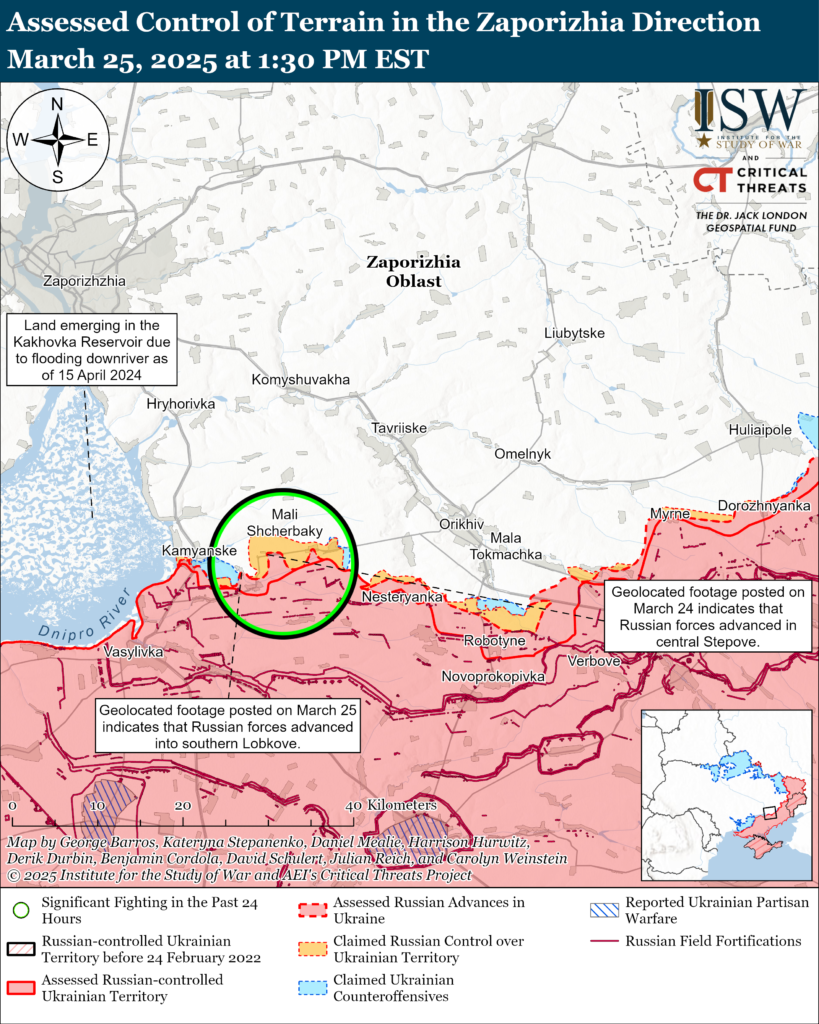
Russian forces conducted limited offensive operations in the Kherson direction on March 25 but did not advance.
Russian forces attacked in the Dnipro direction on March 24 and 25.[70]
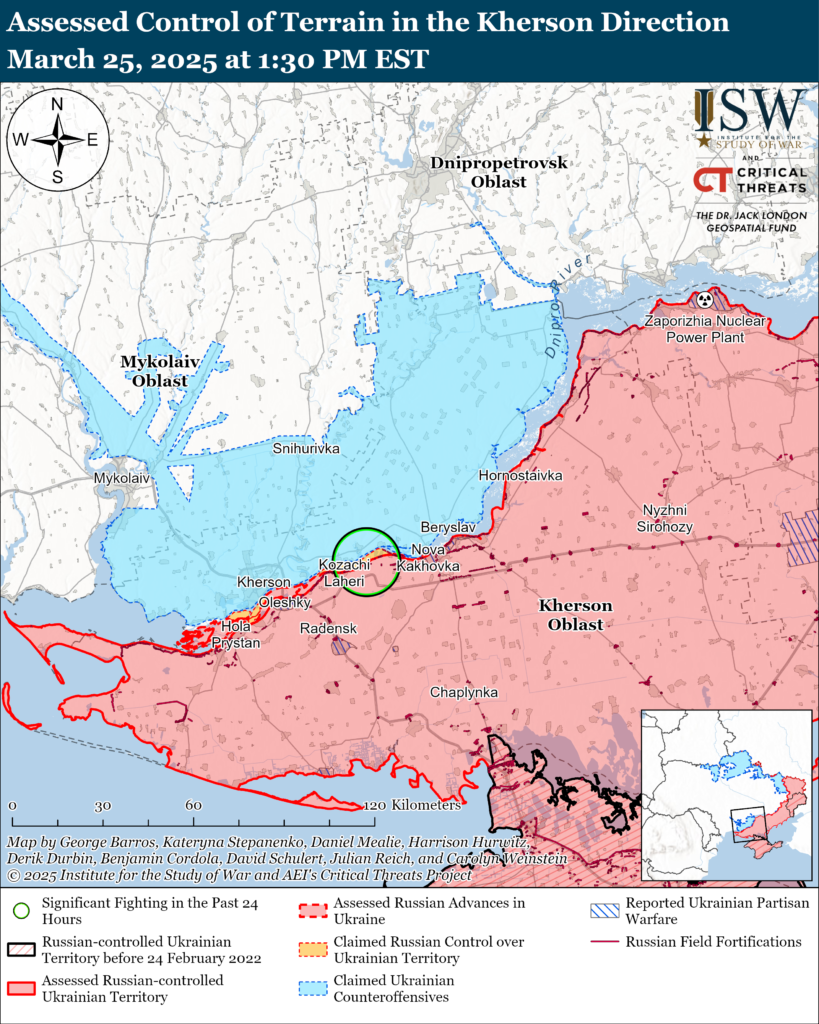
Russian Air, Missile, and Drone Campaign (Russian Objective: Target Ukrainian military and civilian infrastructure in the rear and on the frontline)
Russian forces conducted a series of missile and drone strikes against Ukraine on the night of March 24 and 25. The Ukrainian Air Force reported that Russian forces launched one Iskander-M ballistic missile from occupied Crimea and 139 Shahed and decoy drones from the directions of Kursk City; Millerovo, Rostov Oblast; Primorsko-Akhtarsk, Krasnodar Krai; and occupied Cape Chauda, Crimea.[71] The Ukrainian Air Force reported that Ukrainian forces downed 78 drones and that 34 drones were ”lost,” likely due to Ukrainian electronic warfare (EW) interference. Ukrainian officials reported that Russian forces struck infrastructure in Kharkiv, Sumy, Poltava, Kirovohrad, Kyiv, Cherkasy, and Odesa oblasts and that a Russian missile damaged civilian infrastructure, including a school in Sumy City, injuring 23 children.[72]
Russian Mobilization and Force Generation Efforts (Russian objective: Expand combat power without conducting general mobilization)
The Russian military continues to deny rotations to soldiers who have been fighting in the war in Ukraine for years. Russian President Vladimir Putin stated during a meeting of the Council for Culture and Arts on March 25 that the Russian MoD is considering issues surrounding rotations for servicemembers who went to the front earlier in the full-scale invasion.[73] Putin stated that the “issue is acute” and vaguely claimed that Russian authorities “will proceed from the realities that are developing on the frontline.” Putin claimed that many mobilized servicemembers who have not had rotations have gained so much combat experience over the years that “many of them have become professional soldiers” and work alongside personnel from professional military units, like naval infantry and airborne (VDV) elements.
Russian Technological Adaptations (Russian objective: Introduce technological innovations to optimize systems for use in Ukraine)
Nothing significant to report.
Activities in Russian-occupied areas (Russian objective: Consolidate administrative control of annexed areas; forcibly integrate Ukrainian citizens into Russian sociocultural, economic, military, and governance systems)
ISW is not publishing coverage of activities in Russian-occupied areas today.
Significant activity in Belarus (Russian efforts to increase its military presence in Belarus and further integrate Belarus into Russian-favorable frameworks)
Belarus may be developing military infrastructure to house Russian nuclear warheads. Radio Free Europe/Radio Liberty’s Belarusian service Radio Svaboda reported on March 24 that satellite imagery showed that Belarus expanded the construction of hangars for Iskander ballistic missiles in Asipovichy, Belarus, from October 2022 to February 2025, and that construction work is in its final stage.[74] The New York Times reported in May 2024 that satellite imagery indicated that Belarus had been constructing facilities that could house nuclear warheads at the Belarusian 1405th Artillery Ammunition Base, which is located 12 kilometers away from the Iskander storage site in Asipovichy.[75] Radio Svaboda noted that Belarus is constructing a separate railway to connect the Belarusian 1405th Artillery Ammunition Base with the Iskander ballistic missile storage site in Asipovichy and a “radiation prevention” site in Malaya Garozha (6km northeast of Asipovichy).[76] ISW continues to assess that neither Russia nor Belarus seeks nuclear escalation and that their use of nuclear weapons remains unlikely.
Note: ISW does not receive any classified material from any source, uses only publicly available information, and draws extensively on Russian, Ukrainian, and Western reporting and social media as well as commercially available satellite imagery and other geospatial data as the basis for these reports. References to all sources used are provided in the endnotes of each update.
 Eurasia Press & News
Eurasia Press & News

